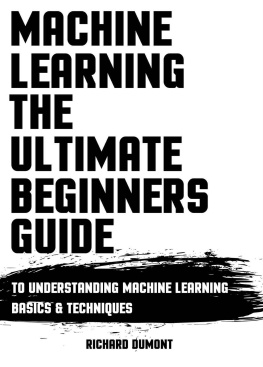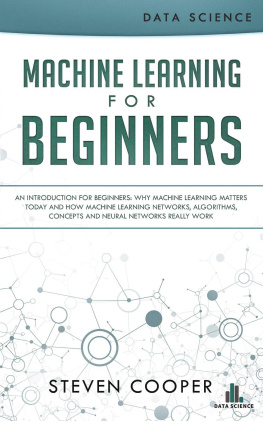Richard Dumont - Machine Learning: The Ultimate Beginners Guide: To Understanding Machine Learning Basics & Techniques
Here you can read online Richard Dumont - Machine Learning: The Ultimate Beginners Guide: To Understanding Machine Learning Basics & Techniques full text of the book (entire story) in english for free. Download pdf and epub, get meaning, cover and reviews about this ebook. year: 0, genre: Computer. Description of the work, (preface) as well as reviews are available. Best literature library LitArk.com created for fans of good reading and offers a wide selection of genres:
Romance novel
Science fiction
Adventure
Detective
Science
History
Home and family
Prose
Art
Politics
Computer
Non-fiction
Religion
Business
Children
Humor
Choose a favorite category and find really read worthwhile books. Enjoy immersion in the world of imagination, feel the emotions of the characters or learn something new for yourself, make an fascinating discovery.
- Book:Machine Learning: The Ultimate Beginners Guide: To Understanding Machine Learning Basics & Techniques
- Author:
- Genre:
- Year:0
- Rating:5 / 5
- Favourites:Add to favourites
- Your mark:
- 100
- 1
- 2
- 3
- 4
- 5
Machine Learning: The Ultimate Beginners Guide: To Understanding Machine Learning Basics & Techniques: summary, description and annotation
We offer to read an annotation, description, summary or preface (depends on what the author of the book "Machine Learning: The Ultimate Beginners Guide: To Understanding Machine Learning Basics & Techniques" wrote himself). If you haven't found the necessary information about the book — write in the comments, we will try to find it.
Richard Dumont: author's other books
Who wrote Machine Learning: The Ultimate Beginners Guide: To Understanding Machine Learning Basics & Techniques? Find out the surname, the name of the author of the book and a list of all author's works by series.
Machine Learning: The Ultimate Beginners Guide: To Understanding Machine Learning Basics & Techniques — read online for free the complete book (whole text) full work
Below is the text of the book, divided by pages. System saving the place of the last page read, allows you to conveniently read the book "Machine Learning: The Ultimate Beginners Guide: To Understanding Machine Learning Basics & Techniques" online for free, without having to search again every time where you left off. Put a bookmark, and you can go to the page where you finished reading at any time.
Font size:
Interval:
Bookmark:
MACHINE LEARNING
THE ULTIMATE BEGINNERS GUIDE TO UNDERSTANDING
MACHINE LEARNING BASICS & TECHNIQUES
Richard Dumont
Copyright Notice.
Richard Dumont
All rights reserved. No part of this publication may be reproduced, distributed or transmitted by any means or in any form, including but not limited to photocopying, recording, or other electronic or mechanical methods, without the prior written permission of the publisher, except in the case of brief quotations embodied in reviews and certain noncommercial uses acceptable to the copyright law.
Trademarked names appear in an editorial style without trademark symbols accompanying every occurrence of trademark names throughout the ebook. These names are used with no intention to infringe on the copyrights of respective owner trademarks. The information in this book is distributed on an "as is" basis, exclusively for educational purposes, without warranty. Neither the author nor the publisher shall have any liability to any person or entity with respect to any loss or damage caused or alleged to be caused directly or indirectly by the information contained in this book.
By reading this document, the reader agrees that Richard Dumont is under no circumstances responsible for any losses, direct or indirect, which are incurred as a result of the use of information contained within this document, including, but not limited to, errors, omissions or inaccuracies.
Table of Contents
Learning, like intelligence, covers such a broad range of processes that it is difficult to define precisely. A dictionary definition includes phrases such as to gain knowledge, or understanding of, or skill in, by study, instruction, or experience, and modification of a behavioural tendency by experience. Zoologists and psychologists study learning in animals and humans. In this book, we focus on learning in machines.
Nowadays, machine learning is a popular word, generally in relation to artificial intelligence and big data. But have any idea what precisely it is? It is actually artificial intelligence's sub-set where computer algorithms are utilized for learning data and information autonomously. Machine learning computers have the ability to change and enhance their algorithms all by themselves.
It's completely about listing computers in the job of sorting via huge amount of data which modern technology has enabled us to produce (also known as Big Data). Its prime focus is on the growth of computer programs which can teach themselves for emerging and changing when unveiled to new data.
Machine Learning algorithms are wide range of tools; online learning tools predict data on the fly. These tools are capable of learning trillions of observations one by one. They predict and learn simultaneously. Other algorithms like Random Forest and Gradient Boosting are also exceptionally fast with large data. However, statistical modelling is generally applied for smaller data with fewer attributes or end up above the fit.
The smaller assumptions in the predicted model will be the prognostic power. Machine learning, as the name implies, requires a minimal effort. Machine learning works on repetitions where the computer tries to find patterns hidden in the data. Since the machine works on comprehensive data and is independent of all assumptions, predictive power is usually very strong for these models.
The statistical model is intensive in mathematics and is based on coefficient estimation. This requires the model to understand the relationship between the variable before it is introduced.
There are several parallels between animal learning and machine learning. Indeed, many techniques in machine learning derive from the efforts of psychologists to make more accurate their theories of animal and human learning through computational models. It also seems likely that the concepts and techniques that researchers are exploring in machine learning can illuminate certain aspects of biological learning.
It is very interesting to know the applications of machine learning. Google and Facebook use Machine learning extensively to push their respective ads to the relevant users. Here are a few applications that you should know:
- Banking & Financial services: Machine learning can be used to predict the customers who are likely to default from paying loans or credit card bills. This is of paramount importance as machine learning would help the banks to identify the customers who can be granted loans and credit cards.
- Healthcare: It is used to diagnose deadly diseases (e.g. cancer) based on the symptoms of patients and tallying them with the past data of similar kind of patients.
- Retail: It is used to identify products which sell more frequently (fast moving) and the slow moving products which help the retailers to decide what kind of products to introduce or remove from the shelf.
Also, machine learning algorithms can be used to find which two / three or more products sell together. This is done to design customer loyalty initiatives which in turn help the retailers to develop and maintain loyal customers.
Presently, computers are enabled by machine learning algorithms to interact with humans, find terrorist suspects, write and publish sport match reports and drive cars autonomously. This will influence many industries and the jobs within them, and for this purpose, every manager must have some grasp at least of what machine learning is and how it is developing.
Currently, it is possible for machine to quickly create models which can analyse more complex and bigger data and supply more relevant and faster results, in fact on a larger scale. And by producing exact models, a company has a better opportunity to identify profitable chances or ignoring strange risks.
IoT machines are producing a massive amount of data and machine learning is completely being employed for analyzing and reading that data in order to help enhance client service and efficiency, and lessen energy consumption and costs. For producing a good learning system, you require:
- Ensemble modeling
- Scalability
- Iterative and automation process
- Basic and advanced algorithms
- Data preparation capabilities
Air quality and several types of energy consumption implement artificial intelligence, cloud computing and big data for mapping nonlinear and complex air pollution trends effectively and relevantly. The technique employs deep machine learning and provides intelligent tips to managers and users on saving energy and getting better air quality. Now the solutions can be suggested by machine learning, thanks to this technology. In fact, the equipment can be identified from a single metering point.
For getting the most value from machine learning, you should know about pairing the best algorithms with the correct processes and tools. Although, this is one of the largest trends to detect everything and anything nowadays, more research needs to be done for testing the algorithm
Work on machine learning is now converging from several sources. These different traditions bring different methods and different vocabularies that are now being assimilated into a more unified discipline. Here is a brief list of some of the separate disciplines that have contributed to machine learning;
- Brain models : non-linear elements with weighted inputs as simple models of biological neurons. The networks of these elements have been studied by several researchers, including [McCulloch and Pitts, 1943, Hebb, 1949, Rosenblatt, 1958] and, more recently, by Gluck and Rumelhart, 1989, Sejnowski, Koch and Churchland, 1988.
Font size:
Interval:
Bookmark:
Similar books «Machine Learning: The Ultimate Beginners Guide: To Understanding Machine Learning Basics & Techniques»
Look at similar books to Machine Learning: The Ultimate Beginners Guide: To Understanding Machine Learning Basics & Techniques. We have selected literature similar in name and meaning in the hope of providing readers with more options to find new, interesting, not yet read works.
Discussion, reviews of the book Machine Learning: The Ultimate Beginners Guide: To Understanding Machine Learning Basics & Techniques and just readers' own opinions. Leave your comments, write what you think about the work, its meaning or the main characters. Specify what exactly you liked and what you didn't like, and why you think so.






